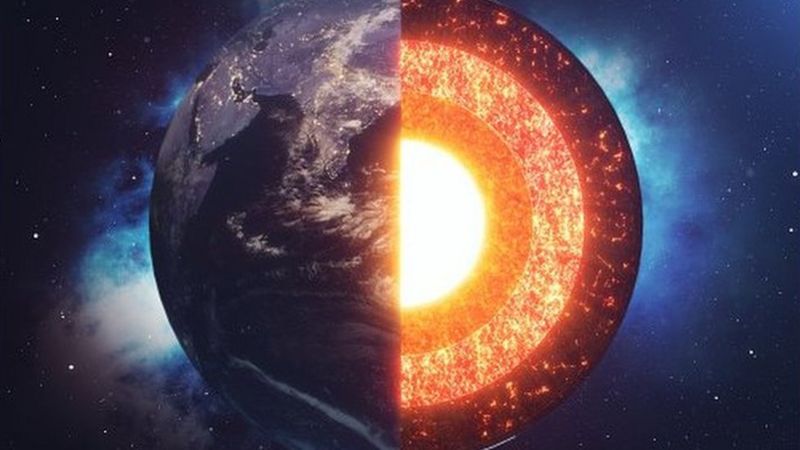In our daily lives, few of us think about what is happening beneath our feet. Not exactly right under our feet, but deep down, where, as we were taught in school, a molten magma floats the metallic core. Yes, we know that sometimes something goes wrong inside the planet, resulting in earthquakes and volcanic eruptions, but those usually happen far away and don’t seem too terrifying.
However, the processes that take place in our planet’s core are of great interest to geophysicists. Recently, they discovered that the Earth’s core, which has a radius of 3,500 kilometers, is located at a depth of 2,900 kilometers, and is thought to be made of an iron-nickel alloy, has slowed down and almost stopped rotating. This could be a prelude to reversing its direction of rotation.
According to scientists, this is no cause for panic, and similar events have occurred in Earth’s history, even in recent memory.
As geophysicists Yang I and Xiaodun Sun of Peking University detailed in their study published in Nature Geoscience, “The inner core has almost stopped rotating in the last decade, and now it may start rotating again, as it did in the early 1970s.
The fact that the Earth’s inner geosphere rotates relative to the mantle was revealed in 1996 by the work of Sun and his colleague, seismologist Paul Richards of Columbia University. Before that, there was only an unconfirmed theory that the inner core might rotate separately from the rest of the planet, as indicated indirectly by the Earth’s magnetic field.
But Sun and Richards analyzed records of the passage of seismic waves through the inner core from so-called double earthquakes that occurred from 1967 to 1995, stretching from the South Atlantic to Alaska. Their premise was that if the core wasn’t moving, these shock waves would follow the same path. It turned out, however, that the waves were traveling through the core at a slightly faster rate during this period, confirming their theory of core rotation.
With the core’s rotation firmly established, scientists have tried to calculate how fast it is spinning. Initially, it was thought that a full rotation of the core, influenced by electromagnetic forces and balanced gravitational forces, would take about 400 years. Later, a theory emerged that the rotation of the geosphere is much slower, possibly taking a thousand years or more to complete a full rotation. The question remains open, but it doesn’t affect the rotation process.
Now Chinese scientists have gone back to the archives. By comparing old and new data from nearly identical measurements of shock wave passage through the core, they’ve found that since about 2009, significant temporal variations in wave passage have almost ceased.
“This global sequence of events suggests that the inner core has recently slowed down,” Yang and Sun say. According to the researchers, this recent slowing of the iron core’s motion could indicate its intention to change its direction of rotation, and that such changes occur about every 70 years.
Based on their calculations, the researchers believe that a small difference in the effects of electromagnetic and gravitational forces could be enough to first slow down and then change the direction of the core’s motion.
In addition, decades of observations of climate, global average temperature, and sea level rise reveal a pattern: these phenomena are also curiously synchronized.
According to Yang and Sun, these slow and barely noticeable shifts in the inner core’s rotation, which occur every 60-70 years, point to a “resonance system in different layers of the Earth,” as if the entire planet were humming to a melody that only it can hear.
Since the inner core is dynamically linked to the outer layers by electromagnetic and gravitational forces, the Chinese researchers’ study could shed light on how processes deep inside the planet influence what happens on its surface, the thin layer where we live.
A logical conclusion, a nice finale? Perhaps, but a grain of skepticism should be added.
“This is a very careful study by excellent people who have gathered an enormous amount of information,” says seismologist John Vidale of the University of Southern California. “But in my opinion, none of the models presented can fully explain all this information.”
Vidale himself published a study last year suggesting that the core is spinning much faster, completing a full rotation every six years or even less.
There is another theory that Vidale doesn’t dismiss. According to this theory, the core’s movements are chaotic; it actively rotated from 2001 to 2013, then apparently froze.
Hrvoje Tkalčić, a professor of geophysics at the Australian National University, claims in his work that the cycle of the core is not 70 years, but 20-30 years. He believes that the geophysical community is as divided on this issue as it was before, and compares seismologists to doctors trying to examine the internal organs of patients without proper equipment.
Tkalčić says, “Our understanding of Earth’s internal structure is still too superficial,” suggesting that many more surprises may be in store, including the possibility of finding another sphere of smaller diameter in the metallic core, similar to a matryoshka doll.
“Something is definitely happening,” agrees Vidale, “and I think we’ll find out, but it may take another decade.

